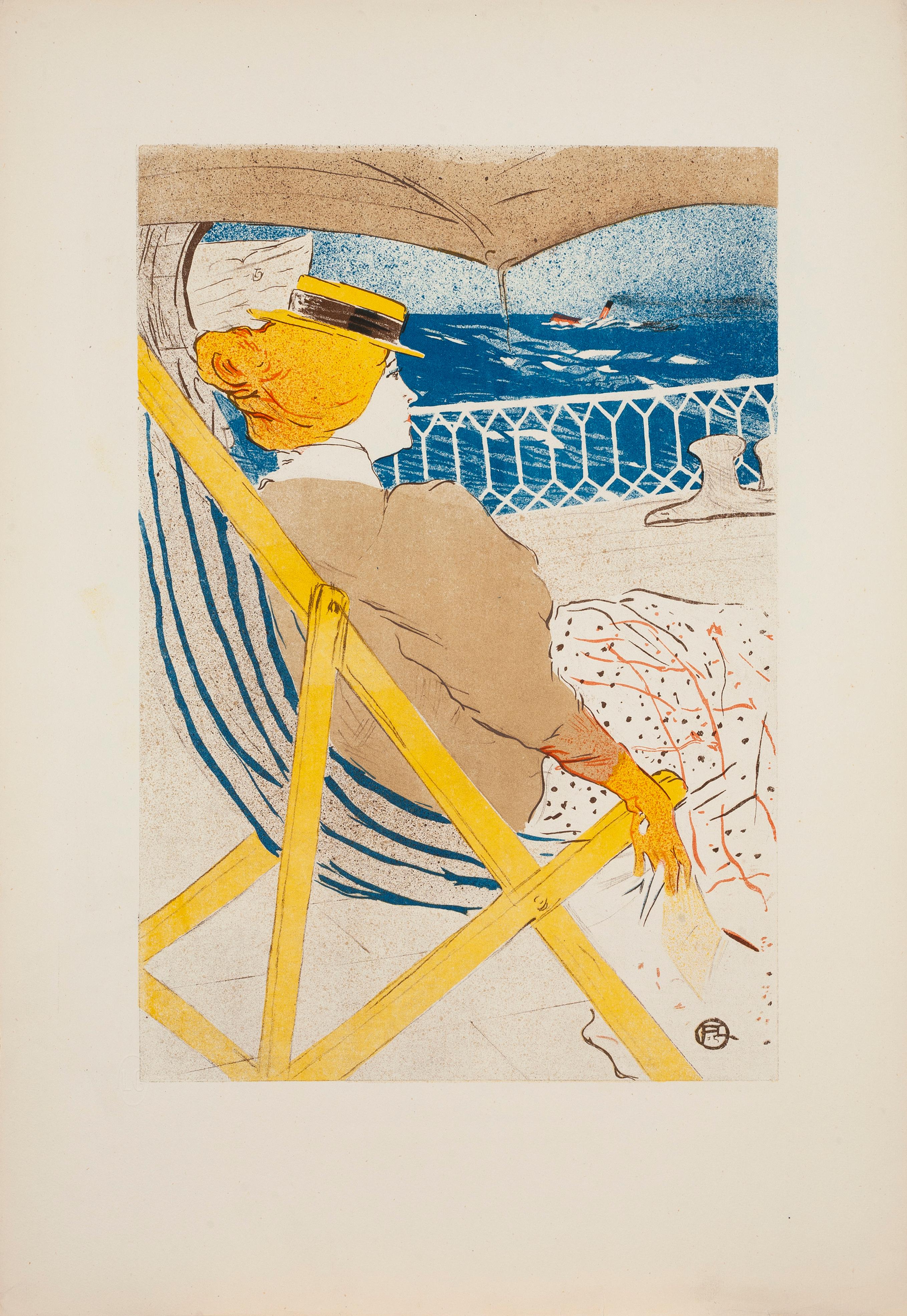Camille PissarroQuai Boïeldieu, à Rouen by Camille Pissarro - Landscape lithographcirca 1896
circa 1896
About the Item
- Creator:Camille Pissarro (1831-1903, French)
- Creation Year:circa 1896
- Dimensions:Height: 10.91 in (27.7 cm)Width: 14.18 in (36 cm)
- Medium:
- Movement & Style:
- Period:
- Condition:
- Gallery Location:London, GB
- Reference Number:1stDibs: LU261213960842
Camille Pissarro
Camille Pissarro was one of the most influential members of the French Impressionist movement and the only artist to participate in all eight Impressionist exhibitions.
Born in July of 1830 on the island of Saint Thomas in the Danish West Indies, Camille was the son of Frédéric and Rachel Pissarro. At the age of 12, he went to school in Paris, where he displayed a penchant for drawing. He returned again to Paris in 1855, having convinced his parents to allow him to pursue a career as an artist rather than work in the family import/export business. Camille studied at the Académie Suisse alongside Claude Monet, and, during this time, he met Paul Cézanne, Édouard Manet and Pierre-Auguste Renoir.
In 1869, Camille settled in Louveciennes. The outbreak of the Franco-Prussian War in 1870 prompted him to move to England, and, with Monet, Camille painted a series of landscapes around Norwood and Crystal Palace, while studying English landscape painting in the museums. Upon returning a year later at the end of the War to Louveciennes, Camille discovered that only 40 of his 1,500 paintings — almost 20 years’ work — remained undamaged.
Camille settled in Pontoise in the summer of 1871, remaining there and gathering a close circle of friends around him for the next 10 years. He reestablished relationships with Cézanne, Manet, Monet, Renoir and Edgar Degas, expressing his desire to create an alternative to the Salon, so that their group could display their own unique styles. Camille married Julie Vellay, with whom he would have seven children. Cézanne repeatedly came to stay with them, and, under Camille’s influence, he learned to study nature more patiently, even copying one of Camille’s landscapes in order to learn his teacher’s technique.
The first Impressionist group exhibition, initiated by Monet in 1874, earned the Impressionists much criticism for their art. While mainly interested in landscape, Camille introduced people — generally, peasants going about their rural occupations — and animals into his works, and they often became the focal point of the composition. It was this unsentimental and realistic approach, with the complete absence of any pretense, which seemed to stop his work from finding appreciation in the general public.
One of the few collectors who did show interest in Camille’s work was a bank employee named Paul Gauguin, who, after acquiring a small collection of Impressionist works, turned to Camille for advice on becoming a painter himself. For several years, Gauguin closely followed his mentor, and, although their friendship was fraught with disagreement and misunderstandings, Gauguin still wrote shortly before Camille’s death in 1906: “He was one of my masters, and I do not deny him.”
In the 1880s, Camille moved from Pontoise to nearby Osny, before Eragny, a small village much further from Paris. At a time when he was dissatisfied with his work, in 1885, Camille met both Paul Signac and Georges Seurat. He was fascinated by their efforts to replace the intuitive perceptive approach of the Impressionists with a “Divisionist” method, or scientific study of nature’s phenomena based on optical laws. Despite having reached his mid-50s, Camille did not hesitate to follow the two young innovators. The following year, he passed on this new concept to Vincent Van Gogh, who had just arrived in Paris and was keen to learn of the most recent developments in art. However, after a few years, Camille felt restricted by Seurat’s theories and returned to his more spontaneous technique while retaining the lightness and purity of color acquired during his Divisionist phase.
In the last years of his life, Camille divided his time between Paris, Rouen, Le Havre and Eragny, painting several series of different aspects of these cities, with varying light and weather effects. Many of these paintings are considered among his best and make for an apt finale to his long and prodigious career.
When Camille Pissarro died in the autumn of 1903, he had finally started to gain public recognition. Today his work can be found in many of the most important museums and collections throughout the world.
Find original Camille Pissarro art on 1stDibs.
(Biography provided by Stern Pissarro Gallery)
- ShippingRetrieving quote...Ships From: London, United Kingdom
- Return PolicyA return for this item may be initiated within 7 days of delivery.
- Le Café Georges à Cannes by H. Claude Pissarro - PastelBy Hughes Claude PissarroLocated in London, GB*UK BUYERS WILL PAY AN ADDITIONAL 20% VAT ON TOP OF THE ABOVE PRICE Le Café Georges à Cannes by H. Claude Pissarro (b. 1935) Pastel on card 37 x 51 cm (14 ⁵/₈ x 20 ¹/₈ inches) Signe...Category
21st Century and Contemporary Post-Impressionist Landscape Prints
MaterialsPastel
- Le Village de Landel by Paulémile Pissarro - etchingLocated in London, GBSOLD UNFRAMED Le Village de Landel by Paulémile Pissarro (1884 - 1972) Etching 17.2 x 23.7 cm (6 ¾ x 9 ⅜ inches) Signed lower right, Paulémile-Pissarro and numbered lower left, 2e e...Category
20th Century Post-Impressionist Landscape Prints
MaterialsEtching
- Series - Monet's House by Lélia Pissarro - ScreenprintBy Lelia PissarroLocated in London, GBSeries - Monet's House by Lélia Pissarro (B. 1963) Serigraph 38 x 48 cm (15 x 18 ⁷/₈ inches) Signed and numbered Printed in an edition of 300 Artist's Biography: Born in Paris in 19...Category
21st Century and Contemporary Post-Impressionist More Prints
MaterialsScreen
- Kerfany by Ludovic-Rodo Pissarro - Wood engravingBy Ludovic-Rodo PissarroLocated in London, GBKerfany by Ludovic-Rodo Pissarro (1878-1952) Wood engraving 10.9 x 13.9 cm (4 ¹/₄ x 5 ¹/₂ inches) Initialled and titled in the plate Signed lower right, Ludovic Rodo and numbered low...Category
20th Century Post-Impressionist Landscape Prints
MaterialsEngraving
- Quincaillerie by Ludovic-Rodo Pissarro - Wood engravingBy Ludovic-Rodo PissarroLocated in London, GBQuincaillerie by Ludovic-Rodo Pissarro (1878 - 1952) Wood engraving 10.4 x 12.6 cm (4 ¹/₈ x 5 inches) Initialled in the plate, signed lower right, Ludovic Rodo and numbered, 1 Exhib...Category
1910s Post-Impressionist Landscape Prints
MaterialsWoodcut
- Chatter by Orovida Pissarro - EtchingBy Orovida PissarroLocated in London, GBChatter by Orovida Pissarro (1893-1968) Etching 26 x 19 cm (10 ¹/₄ x 7 ¹/₂ inches) Signed and dated lower right Orovida 1927 Inscribed lower left Trial proof no. 18/25 and titled lower middle Artist biography: Orovida Camille Pissarro, Lucien and Esther Pissarro’s only child, was the first woman in the Pissarro family as well as the first of her generation to become an artist. Born in Epping, England in 1893, she lived and worked predominantly in London where she became a prominent member of several British arts clubs and societies. She first learned to paint in the Impressionist style of her father, but after a brief period of formal study with Walter Sickert in 1913 she renounced formal art schooling. Throughout her career, Orovida always remained outside of any mainstream British art movements. Much to Lucien's disappointment she soon turned away from naturalistic painting and developed her own unusual style combining elements of Japanese, Chinese, Persian and Indian art. Her rejection of Impressionism, which for the Pissarro family had become a way of life, together with the simultaneous decision to drop her famous last name and simply use Orovida as a ‘nom de peintre’, reflected a deep desire for independence and distance from the weight of the family legacy. Orovida's most distinctive and notable works were produced from the period of 1919 to 1939 using her own homemade egg tempera applied in thin, delicate washes to silk, linen or paper and sometimes embellished with brocade borders. These elegant and richly decorative works generally depict Eastern, Asian and African subjects, such as Mongolian horse...Category
1920s Post-Impressionist Figurative Prints
MaterialsEtching
- La PassagéreLocated in Columbia, MOHENRI DE TOULOUSE-LAUTREC La Passagère 1948 Lithograph on paper Ed. 166/740 20.5 x 14 inchesCategory
19th Century Post-Impressionist Figurative Prints
MaterialsLithograph
- La Loge au Mascaron DoréLocated in Columbia, MOHENRI DE TOULOUSE-LAUTREC La Loge au mascaron doré 1948 Lithograph on paper Ed. 166/740 20.5 x 14 inchesCategory
19th Century Post-Impressionist Figurative Prints
MaterialsLithograph
- Miss Ida HeathLocated in Columbia, MOHENRI DE TOULOUSE-LAUTREC La Loge au mascaron doré 1948 Lithograph on paper Ed. 166/740 20.5 x 14 inchesCategory
19th Century Post-Impressionist Figurative Prints
MaterialsLithograph
- Amazone et TonneauLocated in Columbia, MOHENRI DE TOULOUSE-LAUTREC Amazone et Tonneau 1948 Lithograph on paper Ed. 166/740 20.5 x 14 inchesCategory
19th Century Post-Impressionist Figurative Prints
MaterialsLithograph
- Cecy LoftusLocated in Columbia, MOHENRI DE TOULOUSE-LAUTREC Cecy Loftus 1948 Lithograph on paper Ed. 166/740 20.5 x 14 inchesCategory
19th Century Post-Impressionist Figurative Prints
MaterialsLithograph
- Blanche et NoireLocated in Columbia, MOHENRI DE TOULOUSE-LAUTREC Blanche et Noire 1948 Lithograph on paper Ed. 166/740 20.5 x 14 inchesCategory
19th Century Post-Impressionist Figurative Prints
MaterialsLithograph






